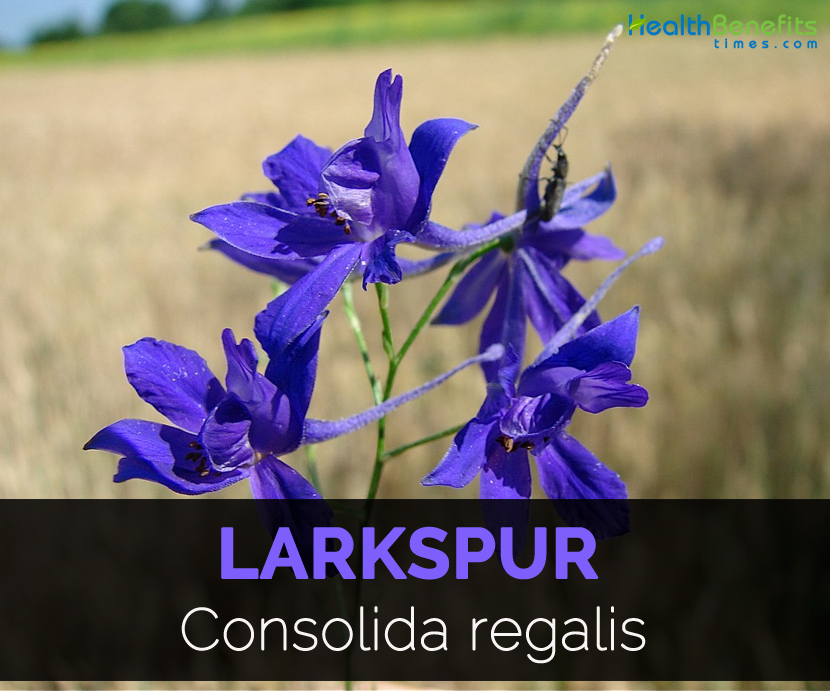| Larkspur Quick Facts | |
|---|---|
| Name: | Larkspur |
| Scientific Name: | Consolida regalis |
The leaves are palmate and variously cut or divided. The flowers are mostly blue, but some are scarlet, red, bluish, white, or even yellow, in cultivated forms. Flower forms in groups along a single stalk like gladioli and color ranges from whites and yellows to deep reds, purples and blues. Each flower has five petals and a protruding centers its spur. The corolla consists of two sets of two petals each, the lower bearing a slender claw extending into the large calyx spur. The root is simple and slender; capsule-fruit or seed. Odour faint; taste bitter, then biting, acrid. Perennial larkspurs tend towards blue flowers but vary to pink, red, white and yellow.
Habitat
The plant is grown on sandy or chalky soils and found at an altitude of 0 to 1200 meters above sea level. It is found in dry weedy places and roadside ditches and in cereal crop fields. The species is grown as an ornamental plant. Seeds are mildly diuretic, anthelmintic, vasodilator, purgative and hypnotic.
Facts About Larkspur
| Name | Larkspur |
|---|---|
| Scientific Name | Consolida regalis |
| Common/English Name | Lark’s Heel, Lark’s Claw, Larkspur, Knight’s Spur, Royal knight’s-spur, Rocket-larkspur, Forking larkspur, Field larkspur, Branching larkspur, Staggerweed, Delphinium, Stavesacre |
| Name in Other Languages | German: Acker-Ritterspor, Ackerrittersporn, Rispiger Feldrittersporn; Danish: Korn-ridderspore; French: Dauphinelle consoude; English: Field larkspur, Forking larkspur, Rocket larkspur, Royal knight’s-spur; Czech: Ostrožka stra; Denmark: Korn-ridderspore; Poland: Ostr¢zeczka polna Norway: kerridderspore Sweden: Riddarsporre |
| Plant Growth Habit | Annual herbaceous plant |
| Plant Size | 30–80 cm (12–31 in) high |
| Stem | Erect, hairy |
| Leaf | Alternately arranged |
| Medicinal parts | The root and seeds |
| Flowering Season | May through August |
| Flower | Dark blue or purple |
Uses
The Hopi tribes used the pollen of S. Scaposum, by grinding the flowers with corn to make blue meal (blue pollen). Seldom used internally and only when prescribed by physicians of experience.
The flowers and leaves were extensively used in the United States army during the rebellion to kill lice and it is pretty well authenticated that the same substance forms the basis of many preparations offered for the destruction of all noxious insects whose room is better than their company. Dr. Brown: “A tincture of the seeds, it is said, will cure Asthma and Dropsy, also a specific for cholera morbus.”
Dose
1 oz. of the seeds added to 1 quart of diluted alcohol makes the tincture, of which 10 drops may be given three times a day. This, however, should be used only in extreme cases, and with the approval of persons of knowledge on the subject.
Szivokost, or Alive Bone, is Russia’s Larkspur. They use the herb and flower, but with caution, as Delphinium is very poisonous. However, it has its useful place in Herbal practice if the “how and when” are observed.
Folk Medicine
- As a poultice and wash, but very carefully given.
- For enlarged liver, stomach and intestinal trouble, urinary system, and venereal diseases.
- Decoction of Delphinium for inflammation of the lungs, pleurisy, headaches, tapeworm, female sickness, chronic coughs, toothaches, and when frightened.
- It is used externally to eliminate skin parasites.
- Leaves juice are effective for bleeding piles.
Dose
20 grams to 4 cups of boiling water; do not drink more than 3 cups a day, a mouthful at a time. Decoction of the flower as a poultice when eyes are inflamed with pus. The same decoction as a tea for cramps, convulsions, amenorrhoea.
Clinically
As tablets, ampoules and powder in compounds when muscle tension, or excitement, after operations when the brain and central nerve system has expended involuntary vital energy, Parkinson’s disease, spreading sclerosis, paralysis. Also used in surgery combined with narcotics.
Industrial
A dye of especially beautiful blue colour for silks and woollens is made for the textile industry; also blue writing ink.
References:
https://npgsweb.ars-grin.gov/gringlobal/taxonomydetail.aspx?id=70198
https://pfaf.org/user/Plant.aspx?LatinName=Consolida+regalis
https://botanical.com/botanical/mgmh/l/larksp09.html
https://en.wikipedia.org/wiki/Consolida_regalis
http://temperate.theferns.info/plant/Consolida+regalis
https://www.cabi.org/isc/datasheet/113429
https://en.wikipedia.org/wiki/Consolida_regalis
https://www.farmersalmanac.com/july-flower-lore-12286
http://medicinalherbinfo.org/000Herbs2016/1herbs/larkspur/
https://navajorange.nmsu.edu/detail.php?id=150
http://www.naturalmedicinalherbs.net/herbs/c/consolida-ambigua=larkspur.php
https://www.britannica.com/plant/larkspur-plant
Comments
comments
